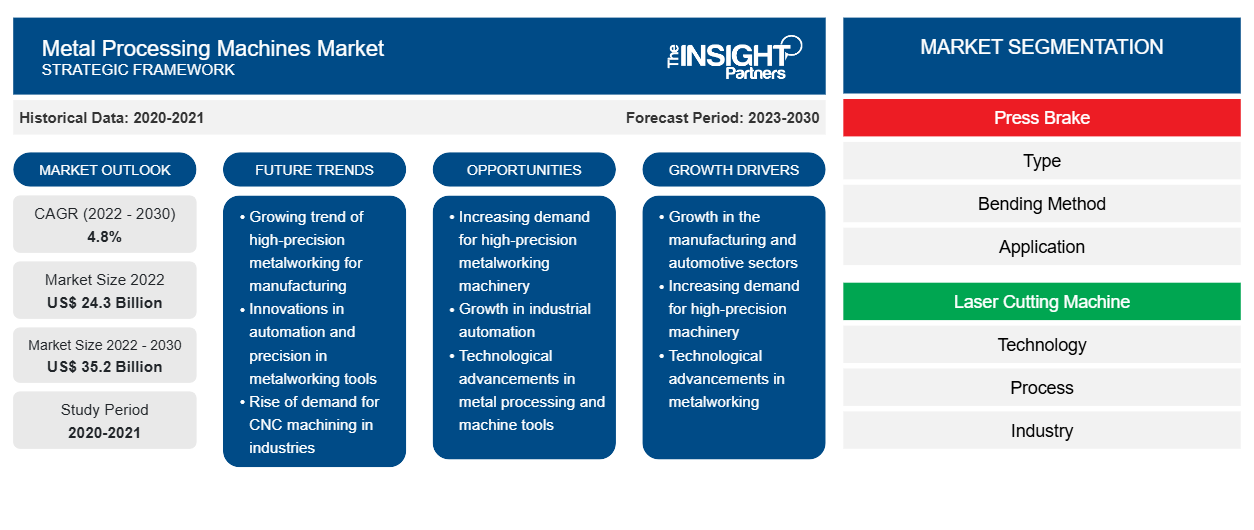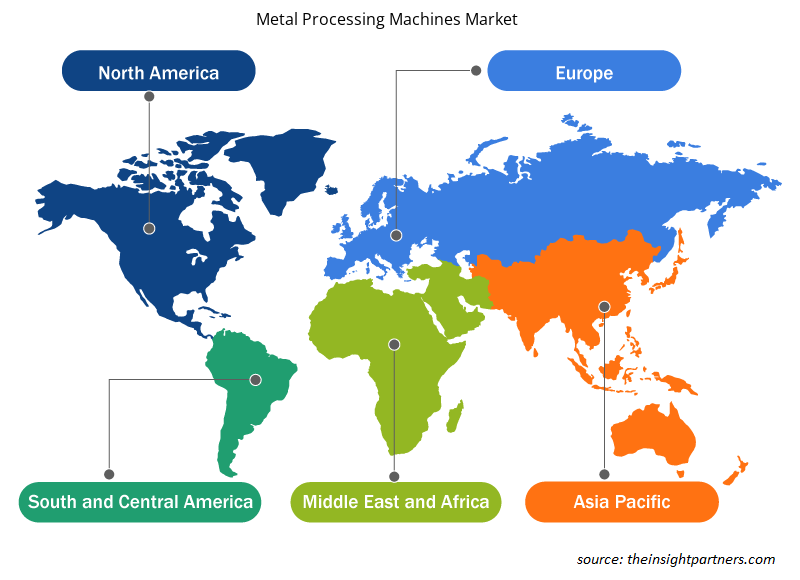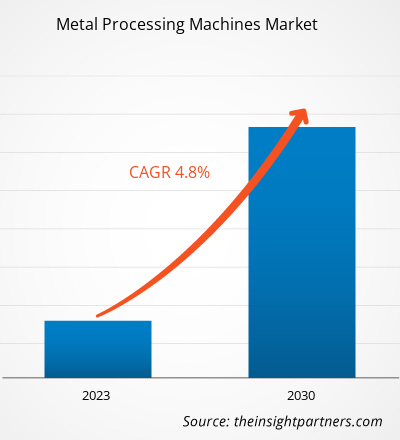金属加工机械市场规模预计将从2024年的296.8亿美元增至2031年的422.9亿美元。预计2025年至2031年期间,该市场的复合年增长率将达到5.3%。工业4.0的普及可能会在未来几年为市场带来新的趋势。
金属加工机械市场分析
全球金属加工机械市场分为四大区域——北美、欧洲、亚太地区和中东。亚太地区凭借其强大的工业基础和技术进步,在金属加工机械市场中占据突出地位。中国在该地区占据主导地位。汽车、航空航天、国防和机械制造等行业的存在推动了亚太地区对金属加工机械的需求。这些行业需要先进的切割、整形和成型解决方案,以满足对精密部件日益增长的需求。中国和印度的国防和航空航天业在推动金属加工机械市场方面发挥着重要作用。持续的技术创新和军费开支的激增促进了市场的增长。3D 打印等增材制造技术能够生产具有复杂几何形状的复杂部件。它还可以减轻飞机的重量,同时保持结构完整性,因此它在复杂部件的生产中被越来越多地采用。这些制造技术对能够提供高精度和高效率的金属加工机械产生了强烈的需求。
工业化程度的提高和汽车制造中心数量的增加,推动了北美对金属加工机械的需求。建筑业的兴起也影响着北美金属加工机械市场的增长。根据美国人口普查局的数据,2024 年美国建筑总价值达 2.1544 万亿美元,比 2023 年的 2.0237 万亿美元增长 6.5%。私人建筑总支出从 2023 年的 1.573 万亿美元增长 5.6% 至 2024 年的 1.6617 万亿美元。由于这项投资,预计金属加工操作(如机器折弯、推式制动器和激光切割)的需求将因制造业活动的增加而增加。
金属加工机械市场概况
预计国防和航空航天领域的投资以及可支配收入增加推动的消费电子产品需求增长将有助于市场的增长。2022 年,泰米尔纳德邦政府发布了《航空航天和国防工业政策》。该政策旨在未来十年吸引约 105 亿美元的大量投资,并创造近 100,000 个就业机会。对最新技术和制造工艺进步的需求预计将进一步推动市场发展。钣金切割在航空航天、汽车、船舶、建筑和电子行业中至关重要。市场正在见证数字技术的不断进步,尤其是在嵌入式系统方面。此外,增材制造、智能机器人和计算机监控系统的创新也是重点。这些趋势预计将通过提高金属加工机械的效率和精度来推动市场增长。
中东和非洲等地区基础设施和建筑业的不断发展对金属加工机械市场产生了积极影响。例如,吉达机场公司计划投资 310 亿美元扩建阿卜杜勒阿齐兹国王国际机场。该机场计划于 2031 年竣工,建成后每年可接待 1.14 亿名乘客。除了主要枢纽之外,埃塞俄比亚和摩洛哥等国的地区机场也有助于改善连通性和经济发展。开普敦国际机场正在进行的扩建项目包括一条新跑道、新的国际和国内候机室、一个航站楼和其他设施。阿联酋对奢华旅游的热爱有助于未来几年基础设施的持续增长。科威特的发展计划(2020-2025 年)主要侧重于经济改革和基础设施发展,预计投资额为 1240 亿美元,其中 40 亿美元用于建造新的机场航站楼。在非洲,尼日利亚和肯尼亚等国家也致力于升级现有的酒店、商务中心、商业枢纽、购物中心和机场,并建造新的设施以满足日益增长的需求。旅游业的蓬勃发展和社会经济地位的提升推动了中东和非洲地区建筑行业的投资。因此,预计投资的增加以及政府在建筑和基础设施建设方面的举措将刺激对建筑机械和设备的需求,从而推动未来几年中东和非洲金属加工机械市场的增长。
为应对日益加剧的地缘政治威胁,全球国防开支在2024年增至约2.46万亿美元。亚洲、中东和北非以及欧洲国家的国防预算大幅增加。增加军费开支有利于推动先进战争技术的采用,例如配备先进通信设备、导弹探测系统以及监视和导航系统的高端军用车辆。此外,随着军事预算的增加,国防部队采购无人驾驶车辆,以提高作战和监视能力,同时又不危及人员生命。因此,国防领域对国防车辆和机械的采购日益增长,正在推动制造业的发展,同时也为维护、维修和大修(MRO)服务业提供了增长机会,进而影响全球金属加工机械的增长。MRO) service sector, influencing the growth of metal processing machines across the globe.
定制此报告以满足您的要求
您可以免费定制任何报告,包括本报告的部分内容、国家级分析、Excel 数据包,以及为初创企业和大学提供优惠和折扣
金属加工机械市场:战略洞察

-
获取此报告的顶级关键市场趋势。此免费样品将包括数据分析,从市场趋势到估计和预测。
金属加工机械市场驱动因素和机遇
汽车和航空航天工业的需求不断增长
汽车和航空航天行业的制造商不断寻求提高生产效率、降低成本和提升产品质量的方法。为了实现这一目标,他们在工厂中部署了高精度、高灵活性和高自动化水平的金属加工机床。这些行业在零部件制造、装配和表面处理等应用中高度依赖金属加工机床。在汽车行业,金属加工机床主要用于制造发动机部件、底盘部件和车身面板。随着新车型的不断推出以及对先进制造技术的需求,未来几年对金属加工机床的需求预计将会上升。美国是最大的汽车制造国。汽车需求的不断增长促使该国不断加大对汽车行业的投资,例如 2021 年马自达-丰田合资企业在亨茨维尔建立的装配厂。1 月份,纯电动汽车 (BEV) 占据约 15% 的市场份额,高于 2024 年 1 月的 10.9%。2025 年 1 月,新纯电动汽车销量增长约 34%,达到 124,341 辆,占据约 15% 的市场份额。该地区四大市场中的三个合计占所有纯电动汽车注册量的约 64%,并经历了显着的两位数增长。据欧洲汽车制造商协会报告,这三个国家包括德国,增幅为 53.5%;比利时,增幅为 37.2%;荷兰,增幅为 28.2%。这表明该行业对金属加工机械的需求巨大。
航空航天业越来越注重轻质材料和先进制造技术,以提高燃油效率和性能。在这个行业中,金属加工机器对于生产机身结构、机翼和起落架等飞机部件至关重要。欧洲飞机制造商空中客车公司计划在中国天津开设第二条 A-320 窄体飞机装配线,以扩大其在中国市场的制造活动。通过此次扩建,到 2026 年空中客车公司每月将能够生产 75 架新型 A-320 neo 系列喷气式飞机。2024 年 10 月,BAE 系统公司获得一份价值 1.84 亿美元(1.68 亿欧元)的合同修改书,为美国陆军再研制 48 辆装甲多用途车辆 (AMPV)。2023 年,俄罗斯在莫斯科附近的陆军-2023 展览会上推出了 BTR-22 8×8 装甲车。 2023年,俄罗斯在“陆军-2023”博览会上展示了一款名为“祖比洛”(Zubilo)的先进无人装甲车。2023年,波兰军备集团宣布与波兰国防部军备局签订三份新合同,将提供约400辆轻型侦察车和轮式装甲运兵车,以及两份重型步兵战车供应合同。
使用自动化制造工艺和机器人技术
随着各行各业对金属产品需求的不断增长,高效且经济的制造解决方案的重要性日益凸显。自动化制造流程和机器人技术相较于传统的手工制造方法具有诸多优势。自动化制造流程可以通过集成计算机辅助设计和计算机辅助制造 (CAD/CAM) 系统来简化金属加工工作流程。这些系统使制造商能够自动执行切割、折弯、焊接和精加工等任务,从而减少对人工的需求并提高整体效率。自动化流程还可以通过减少与手工生产相关的错误和不一致来提高产品质量。2022 年,通快 (TRUMPF) 与 STOPA 合作,推出了一款用于激光管切割机的全新自动装载解决方案。该解决方案将帮助通快将管材从存储系统自动转移到管切割机。此类流程的自动化还可以帮助企业减少非生产时间,从而提高整体生产力。
除了自动化制造工艺外,近年来,机器人技术在金属加工中的应用也备受关注。机器人可以执行各种任务,从原材料处理到最终产品的精加工和包装。它们可以全天候工作,从而提高生产力并缩短交货时间。此外,机器人比人工操作具有更高的精度、准确度和可重复性,从而提高了产品质量和一致性。2020年,Shape Process Automation 与通快 (TRUMPF) 和发那科机器人 (FANUC Robotics) 达成合作。此次合作有望为公司带来机器人激光切割系统方面的专业知识。2024年,nLIGHT, Inc. 宣布在全球推出两款新产品 nfinity 和 ProcessGUARD,专为满足日益增长的先进金属制造需求而设计。SLTL 集团在 2024 年拉杰果德机床展 (Rajkot Machine Tools Show 2024) 上展示了其先进的激光切割机。机器人技术的这些发展使企业能够实现切割精度、降低成本、改进质量和提高效率。福特、波音、空客、丰田、卡特彼勒、苹果和三星等公司都通过金属加工工艺的进步成功提升了生产力。因此,自动化制造工艺和机器人技术的采用为金属加工机械市场的增长带来了巨大的机遇。
金属加工机械市场报告细分分析
促成金属加工机械市场分析的关键部分是产品类型。根据产品类型,金属加工机械市场细分为折弯机、激光切割机、折弯机和激光焊接机。折弯机在2024年占据了最大的市场份额。
金属加工机械市场份额(按地区)分析
金属加工机械市场报告的地理范围主要分为四个主要区域:北美、欧洲、亚太地区和中东。亚太地区的金属加工机械市场细分为中国、日本、韩国、印度尼西亚、马来西亚和亚太其他地区。这些国家正在逐步采用先进技术。此外,低廉的劳动力成本、低税率和强大的商业生态系统正在吸引全球制造业参与者在该地区扩建生产设施。2021 年 10 月,全球最大的铝回收公司之一 Novelis 宣布投资 3.75 亿美元扩建在中国的汽车工业用铝制品回收和生产设施。2022 年 11 月,肯纳金属公司宣布在印度班加罗尔启动其新的金属切削刀片制造工厂。通过这一战略发展,该公司旨在增强其能力和产能,以满足亚太市场日益增长的需求。因此,预计亚太地区不断增长的制造业将在未来几年为金属加工机械市场提供丰厚的机会。
亚太地区在航空航天制造以及维护、维修和大修服务领域占据重要地位。印度斯坦航空有限公司和新加坡科技工程公司等公司利用先进技术制造起落架、涡轮叶片和机身部件。中国、马来西亚和越南依靠金属加工机械来提高建筑设备、钢结构和机械零件的耐用性。该地区可再生能源的增长刺激了金属加工机械在涡轮部件制造中的应用。例如,中国(例如金风科技)和印度(例如苏司兰)的风力涡轮机制造商利用金属加工技术来提高抗疲劳性能。由于电动汽车制造商需要耐用且轻便的部件,预计汽车电气化趋势将推动对金属加工机械的需求。在政府对基础设施和可再生能源项目的支持下,亚太地区未来几年仍将是金属加工机械的主要市场。
医疗科技行业是印度金属加工机械的主要应用领域之一。Meril Life Sciences 等公司在全球范围内出口医疗植入物,利用金属加工技术来提高产品质量并满足国际监管要求。新加坡是航空航天维护、维修和大修 (MRO) 业务的领先国家之一,拥有新加坡科技工程航空航天公司 (ST Engineering Aerospace) 和劳斯莱斯新加坡公司 (Rolls-Royce Singapore) 等大型公司。劳斯莱斯新加坡实里达园区在其制造和 MRO 流程中采用先进的金属加工技术,以提高可靠性。此外,随着石油和天然气工业的发展,新加坡将金属加工技术应用于管道、钻井平台和阀门等海上设备,这也推动了亚太地区对金属加工机械的需求。
金属加工机械市场区域洞察
Insight Partners 的分析师已详尽阐述了预测期内影响金属加工机械市场的区域趋势和因素。本节还讨论了北美、欧洲、亚太地区、中东和非洲以及南美和中美的金属加工机械市场细分和地域分布。

- 获取金属加工机械市场的区域特定数据
金属加工机械市场报告范围
| 报告属性 | 细节 |
|---|---|
| 2024年的市场规模 | 296.8亿美元 |
| 2031年的市场规模 | 422.9亿美元 |
| 全球复合年增长率(2025-2031) | 5.3% |
| 史料 | 2021-2023 |
| 预测期 | 2025-2031 |
| 涵盖的领域 |
通过折弯机
|
| 覆盖地区和国家 |
北美
|
| 市场领导者和主要公司简介 |
|
金属加工机械市场参与者密度:了解其对业务动态的影响
金属加工机械市场正在快速增长,这得益于终端用户需求的不断增长,而这些需求的驱动因素包括消费者偏好的不断变化、技术进步以及对产品优势的认知度不断提高。随着需求的增长,企业正在扩展产品线,不断创新以满足消费者需求,并抓住新兴趋势,从而进一步推动市场增长。
市场参与者密度是指特定市场或行业内企业或公司的分布情况。它表明特定市场空间内竞争对手(市场参与者)的数量相对于其规模或总市值而言有多少。
在金属加工机械市场运营的主要公司有:
- TRUMPF SE + Co KG
- 百超公司
- Prima工业公司
- 阿玛达(印度)私人有限公司
- 萨瓦尼尼意大利有限公司
- 巴伊卡尔马基纳圣维提克公司
免责声明:以上列出的公司没有按照任何特定顺序排列。

- 获取金属加工机械市场主要参与者概览
金属加工机械市场新闻及最新发展
金属加工机械市场评估是通过收集一手资料和二手资料后进行的定性和定量数据进行的,这些数据包括重要的企业出版物、协会数据和数据库。金属加工机械市场的一些发展情况如下:
- 通快 (TRUMPF) 与 SiMa.ai(一家以软件为中心的嵌入式边缘机器学习片上系统公司)签署合作协议,共同开发搭载人工智能 (AI) 的激光器。目标是在不久的将来为多款通快激光系统配备 AI 技术。这包括焊接、切割和打标系统,以及粉末金属 3D 打印机。(通快,新闻稿,2024 年 7 月)
- 百超中国全新销售子公司在上海举行盛大开业典礼,众多嘉宾出席。4月底,百超上海举行了新办公楼的落成典礼,其中包括一个面积超过5000平方米的大型体验中心,随后还举办了“能力日”活动。(百超中国,新闻稿,2024年5月)
- 全球工业激光技术领导者相干公司 (Coherent Corp) 宣布推出 EDGE FLTM 高功率光纤激光器系列,专为机床行业的切割应用量身定制。EDGE FL 系列提供 1.5 kW 至 20 kW 的功率等级,重新定义了价值与性能之间的平衡,以满足光纤激光切割领域对高功率、可靠激光源日益增长的需求。(相干公司,新闻稿,2024 年 10 月)
金属加工机械市场报告覆盖范围和交付成果
《金属加工机械市场规模和预测(2021-2031)》报告对以下领域进行了详细的市场分析:
- 金属加工机械市场规模及全球、区域和国家层面所有主要细分市场的预测
- 金属加工机械市场趋势以及市场动态,例如驱动因素、限制因素和关键机遇
- 详细的 PEST 和 SWOT 分析
- 金属加工机械市场分析涵盖主要市场趋势、全球和区域框架、主要参与者、法规和最新市场发展
- 行业格局和竞争分析,包括市场集中度、热图分析、知名参与者以及金属加工机械市场的最新发展
- 详细的公司简介
- 历史分析(2 年)、基准年、预测(7 年)及复合年增长率
- PEST和SWOT分析
- 市场规模、价值/数量 - 全球、区域、国家
- 行业和竞争格局
- Excel 数据集
近期报告
相关报告
客户评价
购买理由
- 明智的决策
- 了解市场动态
- 竞争分析
- 客户洞察
- 市场预测
- 风险规避
- 战略规划
- 投资论证
- 识别新兴市场
- 优化营销策略
- 提升运营效率
- 顺应监管趋势






















 获取免费样品 - 金属加工机械市场
获取免费样品 - 金属加工机械市场